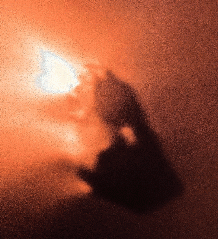The coma has two main constituents.
The Gas Coma
The gas coma consists of molecules liberated from the nucleus by solar heating and sublimation. Once clear of the nucleus, molecules in the coma are exposed to direct solar radiation and can be damaged in various ways. Most molecules are broken apart ("dissociated") within a day of leaving the nucleus. For example,
 and
and
 are both reactions in which a molecule released from the nucleus absorbs
a photon and breaks into two pieces. By convention, the initial molecule
is often referred to as the "parent molecule" while the fragments produced
by the absorption of a solar photon are known as "daughters" (mysteriously,
there are no "sons" in coma physics, only daughters).
are both reactions in which a molecule released from the nucleus absorbs
a photon and breaks into two pieces. By convention, the initial molecule
is often referred to as the "parent molecule" while the fragments produced
by the absorption of a solar photon are known as "daughters" (mysteriously,
there are no "sons" in coma physics, only daughters).It turns out that the daughters are quite easy to observe because they have strong spectral lines at optical wavelengths. In fact, most of the light scattered from a comet at optical wavelengths is scattered by daughters. For this reason, the daughters have received a lot of observational attention and many are well understood. What we would prefer to understand is the origin and abundance of the parent molecules, but the parents generally lack useful optical spectral features. The direct study of parents is a relatively modern enterprise conducted by spacecraft encounters with a handful of comets and, more recently by submillimeter astronomy.
In addition to being photo-dissociated, gas species in comets can also be ionised, as in
 . The ions are susceptible to a
magnetic force due to the solar magnetic field carried by the solar wind.
Consequently, the ions are swept almost radially away from the sun, into a
long, distinctive tail.
. The ions are susceptible to a
magnetic force due to the solar magnetic field carried by the solar wind.
Consequently, the ions are swept almost radially away from the sun, into a
long, distinctive tail.
The outflow speed of the coma is comparable to the speed of sound in the coma gas at the temperature of the nucleus. For a comet near the orbit of Earth, this is about 1 km/s. This speed and the lifetime of molecules to photo-destruction together determine the scale of the cometary coma. In one day, at 1 km/s, the molecules in the coma can travel about 50,000 km and this is the approximate radius of the gas coma.
The Dust Coma
The dust coma consists of dust grains dragged from the nucleus
by the rush of sublimating gas. Once beyond a few tens of nuclear diameters
in altitude, the dust grains are effectively in free flight around the
sun because the nuclear gravity is so weak. The speed of the grains depends
on their size. Very small grains
are quickly accelerated to the gas speed. Large grains may be too heavy
to reach more than a tiny fraction of the gas speed. So long as they
reach a terminal speed greater than the nucleus escape velocity, however,
they will be ejected from the nucleus and become part of the coma. Grains
that are too large to be ejected even from the puny gravity of the nucleus
fall back to the surface and may become part of a rubble mantle.
Cometary dust grains are found at all sizes. The grains that are most
visible to the eye have diameters of about 1 micron (0.001 mm). Grains of
many tens of centimeters can be ejected by the gas flow from an active,
near-sun comet. Many of these grains pass through the Type II tail into
the interplanetary medium, where they feed the Zodiacal Cloud. Many of the
meteors that blaze across the night sky are dust particles from comets.
As far as we can tell, nearly equal masses of dust and gas are ejected per unit time by the comets.
Pictures of comets show that the outgassing is often highly
anisotropic. This is partly because the nuclei of
comets are not uniformly active as a result of the formation of a surface
crust or
"mantle".
Last updated August 2009

| 
| |
| Nucleus | Comet | Jewitt |
|---|